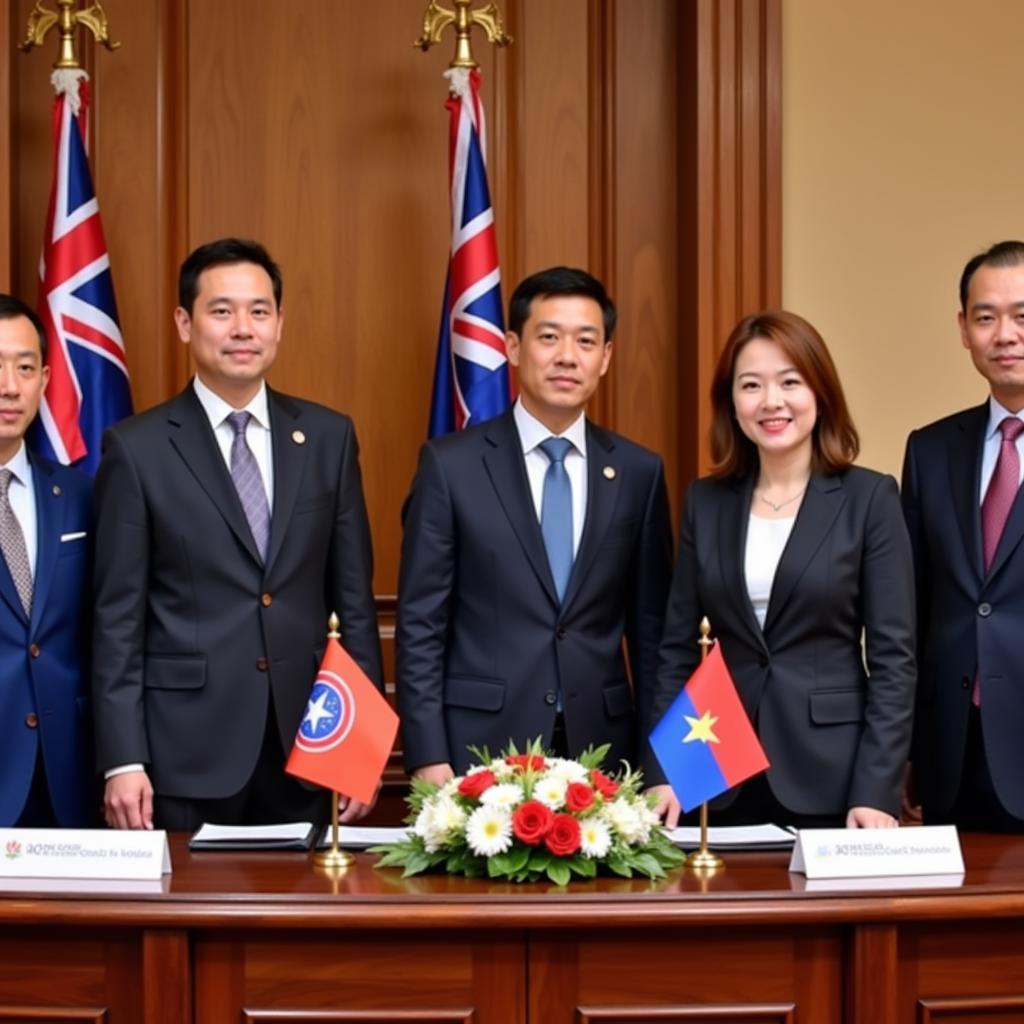The ASEAN Australia New Zealand Free Trade Agreement (AANZFTA) is a comprehensive agreement encompassing trade in goods, services, investment, and intellectual property. Signed in 2009, it represents a significant milestone in economic cooperation between the ten ASEAN member states, Australia, and New Zealand. This comprehensive agreement aims to liberalize trade, promote investment flows, and foster economic integration between the participating countries.
Objectives and Scope of AANZFTA
AANZFTA aims to:
- Eliminate tariffs and reduce non-tariff barriers on a wide range of goods traded between participating countries.
- Liberalize trade in services by providing greater market access and ensuring regulatory transparency.
- Encourage and facilitate investment flows by providing a predictable and transparent investment environment.
- Establish a framework for cooperation on intellectual property rights protection and enforcement.
 AANZFTA Signing Ceremony
AANZFTA Signing Ceremony
Key Features of AANZFTA
- Tariff Reduction and Elimination: AANZFTA has led to the elimination or reduction of tariffs on a wide range of goods traded between participating countries. This has significantly reduced the cost of imports and exports, making businesses in these countries more competitive.
- Trade Facilitation: The agreement includes provisions to streamline customs procedures, simplify documentation requirements, and promote transparency in trade regulations, thus facilitating smoother cross-border trade.
- Services Liberalization: AANZFTA includes comprehensive chapters on trade in services, covering a wide range of sectors. It aims to create a more open and predictable environment for services providers from participating countries.
- Investment Protection: The agreement provides important safeguards for investors from participating countries. It aims to create a more stable and predictable investment climate, encouraging cross-border investment flows.
Benefits of AANZFTA
AANZFTA has brought numerous benefits to the participating countries:
- Increased Trade and Investment: The agreement has led to a significant increase in trade and investment flows between the participating countries, creating new markets and opportunities for businesses.
- Economic Growth: By promoting trade and investment, AANZFTA has contributed to economic growth and development in the participating countries, leading to job creation and improved living standards.
- Enhanced Competitiveness: By reducing trade barriers and promoting competition, AANZFTA has enhanced the competitiveness of businesses in the participating countries, making them more competitive in the global marketplace.
- Regional Integration: AANZFTA has fostered closer economic ties and integration between the ASEAN countries, Australia, and New Zealand, strengthening regional cooperation and collaboration.
Challenges and Opportunities
Despite its successes, AANZFTA also faces some challenges:
- Non-Tariff Barriers: While tariffs have been significantly reduced, non-tariff barriers, such as technical regulations and sanitary and phytosanitary measures, can still hinder trade.
- Implementation Gaps: Differences in interpretation and implementation of the agreement’s provisions among participating countries can create uncertainty for businesses.
- Utilization Rate: The utilization rate of AANZFTA preferences by businesses remains relatively low, indicating that more awareness and capacity building are needed to maximize the agreement’s benefits.
AANZFTA in the Digital Economy
The rise of the digital economy presents both opportunities and challenges for AANZFTA. E-commerce, digital trade, and data flows are increasingly important aspects of international trade, requiring updated rules and regulations to ensure a level playing field for businesses and consumers. AANZFTA parties are actively engaged in discussions and negotiations to modernize the agreement and address these emerging issues.
Conclusion
The ASEAN Australia New Zealand FTA is a testament to the commitment of the participating countries to free trade, economic cooperation, and regional integration. The agreement has yielded significant economic benefits, boosting trade, attracting investment, and promoting closer ties between the ASEAN region, Australia, and New Zealand. As the global trade landscape continues to evolve, AANZFTA remains a vital platform for fostering economic growth, prosperity, and regional stability in the Asia-Pacific region.
FAQs
1. What is the main goal of AANZFTA?
The main goal of AANZFTA is to liberalize trade, promote investment flows, and foster economic integration between the ten ASEAN member states, Australia, and New Zealand.
2. Which countries are part of AANZFTA?
AANZFTA comprises the ten ASEAN member states (Brunei, Cambodia, Indonesia, Laos, Malaysia, Myanmar, the Philippines, Singapore, Thailand, and Vietnam), Australia, and New Zealand.
3. How has AANZFTA benefited businesses?
AANZFTA has benefited businesses by reducing tariffs, opening up new markets, and providing a more stable and predictable environment for trade and investment.
4. What are some of the challenges facing AANZFTA?
Some of the challenges facing AANZFTA include non-tariff barriers, implementation gaps, and the need to adapt to the digital economy.
5. How can I learn more about AANZFTA?
You can find more information about AANZFTA on the websites of the ASEAN Secretariat, the Australian Department of Foreign Affairs and Trade (DFAT), and the New Zealand Ministry of Foreign Affairs and Trade (MFAT).
Need Help?
For further assistance and information, please contact us at:
Phone Number: 0369020373
Email: aseanmediadirectory@gmail.com
Address: Thon Ngoc Lien, Hiep Hoa, Bac Giang, Vietnam.
Our dedicated customer support team is available 24/7 to assist you.

